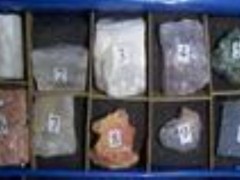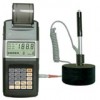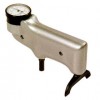Mohs hardness (Mohs hardness) that a standard mineral hardness. Applications will be pyramid-shaped diamond scratching pin depicts the test occurred scratch the surface of minerals, mineralogy or gemology customarily are used on the Mohs hardness.
Scratch with a measured depth of sub-10 to represent the hardness: talc (talc) 1 (hardness minimum), gypsum (gypsum) 2, calcite (calcite) 3, fluorite (fluorite) 4, apatite (apatite) 5, orthoclase (feldspar; orthoclase; periclase) 6, quartz (quartz) 7, topaz (topaz) 8, corundum (corundum) 9, diamond (diamond) 10.
Hardness is not the absolute hardness values, but the order indicated by the hardness value.
Moss (F. Mons) was founded and named after the proposed determination of the relative hardness of 10 kinds of mineral standard minerals. Divided into 10 small to large scale: talc 1, gypsum 2, calcite 3, fluorite 4, apatite 5, orthoclase 6, quartz 7, topaz 8, corundum 9, diamond 10.
Applications for characterization of comparison to determine hardness. If a mineral calcite can carve scratches, but not carved fluorite, its Mohs hardness is 3 to 4, the other analogy. Mohs hardness of only relative, is sketchy. Although the hardness of talc is 1, 10 diamond, corundum is 9, but after microhardness measured the absolute hardness, diamond is 4192 times as talc, corundum 442 times for the talc. Mohs hardness, and convenient, frequent use of field operations.
Mohs hardness is in AD 1812 by the German mineralogist Frederich Mohs (1773-1839) suggested that the greater the hardness value of the more hard. The hardness values fell by each mill to determine is relative, it is not a linear proportion (not that hardness than the hardness of 6, 2 hard 3 times). In addition to the original list of 1 to 10 minerals, there are also other common items collected hardness reference:
:
1 talc (Talc), Graphite (Graphite) Talc is the softest known mineral, common applications with talcum powder.
1.5 skin (skin), natural arsenic
2 Gypsum (Gypsum) uses a wide range of industrial materials
2 to 3 ice cubes (ice)
2.5 nails (nail), amber (Amber), Ivory (Ivory)
2.5 ~ 3 gold (pure gold), Ag (silver), aluminum (aluminium) of gold, silver and commonly used in jewelry, aluminum is common in industrial applications. At least understand gold, K gold, platinum
3 calcite (Calcite), Cu (copper), pearl (Pearl) calcite can be used for engraving materials, is also an important raw material in many industries. Copper first used in decoration, common also for alloy production, transmission media such as the electronics industry.
3.5 Shell (shell)
4 Fluorspar (Fluorite), also known as fluorite can be used for engraving materials, commonly used in metallurgy, chemical industry, building materials industry.
4 ~ 4.5 platinum (Platinum) rare, is precious metals the hardest. Platinum jewelry often used in military industry or process. At least understand gold, K gold, platinum
4 ~ 5 Fe (Iron) commonly used in steelmaking and other industrial applications.
5 apatite (Apatite) Phosphorus is a vital component of biological cytoplasm, commonly used for feed, fertilizer industry, is also an important chemical raw material.
5.5 glass (glass), stainless steel (stainless steel) decoding process Fashion Material - stainless steel (Stainless steel)
6 are feldspar (Orthoclase), Tanzanite Tanzanite (tanzanite), titanium orthoclase as ceramics, glass, enamel Lang, raw materials and manufacturing potash.
6 to 7 teeth (the crown layer) mainly composed of hydroxyapatite.
6 ~ 6.5 soft jade - Xinjiang Hotan jade
6.5 pyrite (Iron pyrite) sulfuric acid sources of raw materials, refined gold, medicinal, etc..
6.5 ~ 7 jadeite - jade or Myanmar jade
7 quartz (Quartz), Amethyst (Amethyst) is a common main raw material for refractories and glass.
7.5 Tourmaline (Tourmaline), zircon (Zircon) is common in jewelry applications
8 Topaz (Topaz) common application of chance encounters in the diamond jewelry
8.5 Golden Beryl (Chrysoberyl) common in jewelry applications
9 corundum (Corudum), chrome, tungsten steel jewelry, abrasive, etc.. Common gems such as rubies, sapphires and other natural stones are corundum; gem "sapphire crystal" (to watch stations Cipian note) likewise the hardness of corundum grade. Fashion Material decoding process - sapphire crystal glass
9.25 Moissanite jewel (Moissanite) gem, bright 2.5 times the extent of the diamond, but the price is about 1 / 10
10 Diamond (Diamond) Earth hardest natural stones, commonly found in jewelry applications. Chance encounter diamond
Greater than 10 diamond nanorods aggregate (aggregated diamond nanorod, ADNR) German scientists in 2005 developed a more rigid material than the diamond, with a wide range of industrial applications.















